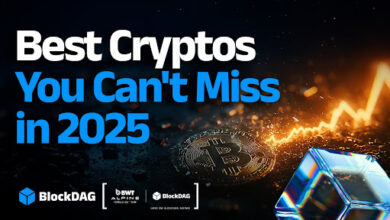Bitcoin Updates: France Embraces Bitcoin and Stablecoins While ECB Advances Digital Euro Plans
- ECB accelerates digital euro plan for 2029 rollout to modernize eurozone finance and reduce cash reliance. - French lawmakers oppose it, citing privacy risks and advocating crypto/stablecoins as alternatives. - Global CBDCs advance, with Hong Kong’s e-HKD pilot and U.S. stablecoin-friendly policies. - Stablecoins like USDC gain traction, outpacing USDT with regulatory compliance and institutional adoption.
The European Central Bank (ECB) is moving forward with its digital euro initiative, aiming for a possible launch in 2029 as part of efforts to update the eurozone’s financial systems and decrease dependence on cash.
Despite these plans, the ECB is encountering opposition within Europe. Lawmakers in France recently passed a resolution against the digital euro, raising issues about privacy, personal economic freedom, and the dangers of centralized oversight. The National Assembly approved a measure urging the government to reject the ECB’s proposed rules and instead support euro-based stablecoins and a national

The ECB’s digital euro project, which started in November 2023, is estimated to require €1.3 billion ($1.5 billion) in funding through 2029, with yearly operating costs projected at €320 million ($369 million), according to the Decrypt article. Should the European Parliament approve the necessary laws by 2026, a pilot could begin in mid-2027, with a full launch in 2029. Meanwhile, France’s crypto-friendly stance includes calls for a Bitcoin reserve, fostering local crypto development, and backing stablecoins as alternatives to the ECB’s CBDC.
The discussion around CBDCs is unfolding alongside the rapid growth of stablecoins, which are increasingly challenging central bank initiatives. JPMorgan analysts observed in a recent
On a global scale, CBDC projects are advancing in various regions. Hong Kong’s e-HKD initiative finished its second pilot in 2025 and is targeting a 2026 launch. This effort, part of the broader "Digital HKD Plus" program, seeks to set standards for programmable digital currencies. In contrast, the United States has prohibited CBDCs domestically via executive order, but has supported stablecoins through legislation such as the GENIUS Act, the Decrypt article reported.
The ECB’s digital euro and the expanding role of stablecoins mark a significant turning point in global finance, as innovation is weighed against concerns about privacy, national control, and systemic stability.
Disclaimer: The content of this article solely reflects the author's opinion and does not represent the platform in any capacity. This article is not intended to serve as a reference for making investment decisions.
You may also like
Viral Surge Ahead: 5 Meme Coins Set for Explosive 1000x Growth as Hype Returns to Crypto Markets

BlockDAG Leads 2025’s Top Crypto Assets as Solana, Sui, and Cardano Drive the Next Phase of Blockchain Growth
Discover why BlockDAG is among the top crypto assets of 2025. With $435M+ raised, 3.5M users, and F1-level global exposure, it’s redefining blockchain momentum.1. BlockDAG (BDAG): Setting a New Standard for Blockchain Growth2. Solana (SOL): Institutional Strength and Market Confidence3. Sui (SUI): Innovation Amid Supply Expansion4. Cardano (ADA): Academic Precision Meets Institutional GrowthConfidence Redefined Across Layer-1 Networks

Zcash Soars 375% as Top Privacy Token in October
Zcash jumps 375% in October, topping privacy coins amid growing global surveillance concerns.Surveillance Crackdowns Fuel Interest in Privacy TokensCan the Momentum Continue?

Sigma Capital CEO Predicts Major Bitcoin Dip Before $1M Surge
Vineet Budki sees Bitcoin dropping 70% before reaching $1M in the next 10 years.Why Such a Big Drop?Long-Term Confidence Remains Strong
